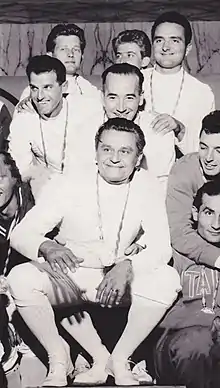| Pál Kovács | |||||||||||||||||||||||||||||||||||||||||||||||||||||||||
|---|---|---|---|---|---|---|---|---|---|---|---|---|---|---|---|---|---|---|---|---|---|---|---|---|---|---|---|---|---|---|---|---|---|---|---|---|---|---|---|---|---|---|---|---|---|---|---|---|---|---|---|---|---|---|---|---|---|
 Hungarian sabre team at the 1960 Olympics, Kovács is in the center, just above Aladár Gerevich | |||||||||||||||||||||||||||||||||||||||||||||||||||||||||
| Personal information | |||||||||||||||||||||||||||||||||||||||||||||||||||||||||
| Born | 17 July 1912 Debrecen, Hungary | ||||||||||||||||||||||||||||||||||||||||||||||||||||||||
| Died | 8 July 1995 (aged 82) Budapest, Hungary | ||||||||||||||||||||||||||||||||||||||||||||||||||||||||
| Height | 1.79 m (5 ft 10 in) | ||||||||||||||||||||||||||||||||||||||||||||||||||||||||
| Weight | 80 kg (176 lb) | ||||||||||||||||||||||||||||||||||||||||||||||||||||||||
| Sport | |||||||||||||||||||||||||||||||||||||||||||||||||||||||||
| Sport | Fencing | ||||||||||||||||||||||||||||||||||||||||||||||||||||||||
| Weapon | sabre | ||||||||||||||||||||||||||||||||||||||||||||||||||||||||
| Hand | right-handed | ||||||||||||||||||||||||||||||||||||||||||||||||||||||||
| Club | Honvéd Tiszti Vívó Klub ÖT Ganz-Mávag SportegyesületMávag SportegyesületVasas Sport Club | ||||||||||||||||||||||||||||||||||||||||||||||||||||||||
Medal record
| |||||||||||||||||||||||||||||||||||||||||||||||||||||||||
Pál Kovács (17 July 1912 – 8 July 1995) was a Hungarian athlete, who began as a hurdler, but eventually switched to fencing.
By the time Kovács won his first fencing gold, in 1936, he had already been a member of the winning Hungarian team at the 1933 World Championships. The Hungarians won team sabre gold in five successive Olympics, lasting from 1936 until 1960. The same team won gold eight back-to-back world championships (including the two Olympics, which double as world championships in their respective years). Kovács also won individual gold in 1952, as well as individual bronze in 1948. In 1980, he became vice-president of the Fédération Internationale d'Escrime. He died in Budapest in July 1995.[1]
See also
References
Wikimedia Commons has media related to Pál Kovács.
- ↑ "Pál Kovács Olympic Results". sports-reference.com. Archived from the original on 17 April 2020. Retrieved 3 June 2010.
This article is issued from Wikipedia. The text is licensed under Creative Commons - Attribution - Sharealike. Additional terms may apply for the media files.